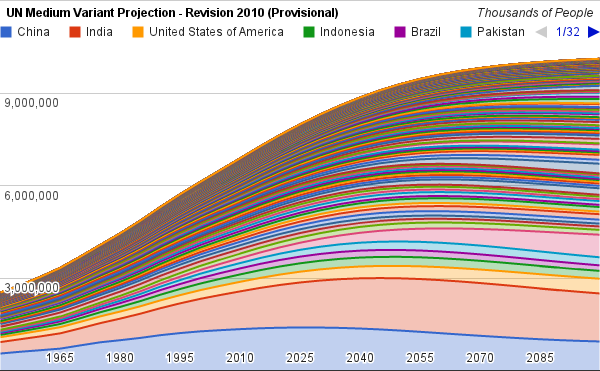-
Carl Haub, Behind the Numbers
UN Releases Early Results of Global Population Projections
April 18, 2011 By Wilson Center StaffThe original version of this article, by Carl Haub, appeared on the Population Reference Bureau’s Behind the Numbers blog.
The United Nations Population Division has released preliminary results of its biennial series of population projections for the world’s countries for the 2010 revision. The projections are expected to be finalized later this month.While the global population for 2010 — 6.873 billion — is slightly lower than estimated in the 2008 revision (6.909 billion), the projected population for 2050 is now higher at 9.295 billion compared with the previous 9.150 projected in 2008. That can also be compared to the 2050 population of 9.485 billion on PRB’s 2010 World Population Data Sheet and 9.256 billion in the International Data Base of the U.S. Census Bureau.
The 2010 UN projections differ from the previous series in two significant ways. First, the projection horizon has been extended to 2100, quite far into the future. Second, the UN no longer assumes a uniform “ultimate” level of the total fertility rate (TFR) for all countries, such as the 1.85 level in its medium variant. Instead, multiple possibilities for each country’s TFR are projected with a probabilistic method based on fertility trends for the 1950-2010 period. Then, the median path of those “tracks” serves as the projected TFR for the medium variant series. The high and low variants, however, will be projected as in the past. Those variants have used an “ultimate” TFR of 2.35 and 1.35 for all countries, respectively.
The projected population of sub-Saharan Africa (SSA) in 2050, the world’s region with by far the largest potential for population growth, is now 1.963 billion, up from 1.753 in the 2008 UN projections. But, since the projections now run to 2100, we can now see beyond mid-century. By 2100, the UN projects that SSA would total an eye-popping 3.4 billion, nearly four times its present size and still be growing by 0.7 percent per year, adding 2 million annually at that time!
Continue reading on Behind the Numbers.
Sources: Population Reference Bureau, UN Population Division, U.S. Census Bureau.
Chart Credit: Data from UN Population Division, created by Schuyler Null. See full chart for interactive version (warning: it’s a lot of data – may slow or crash your browser).
 A Publication of the Stimson Center.
A Publication of the Stimson Center.




